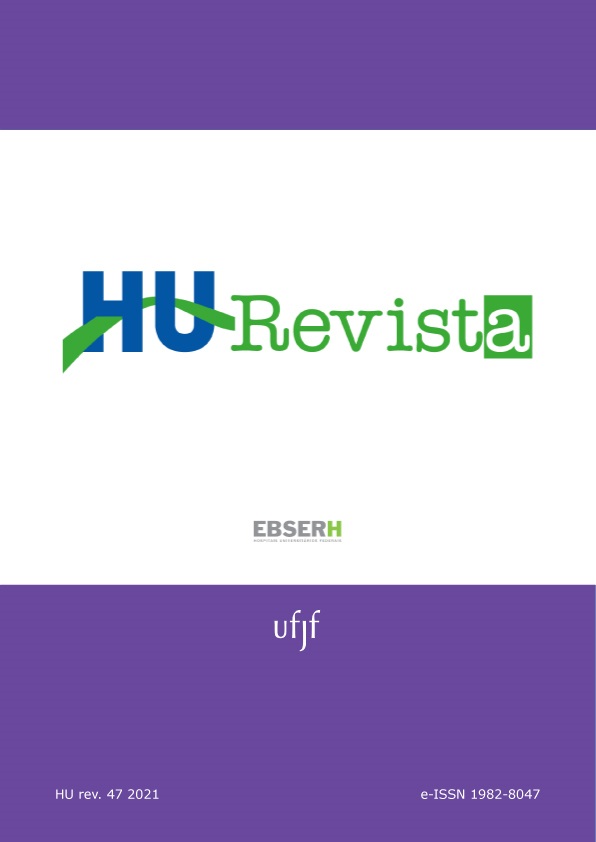Integração ensino-serviço para realização de educação permanente em ações de controle da hanseníase: relato de experiência
DOI:
https://doi.org/10.34019/1982-8047.2021.v47.33963Palavras-chave:
Hanseníase, Atenção Primária à Saúde, Capacitação de Recursos Humanos em Saúde, Educação Continuada em Enfermagem, Educação Médica ContinuadaResumo
Introdução: A atuação dos profissionais de saúde da atenção primária à saúde demonstra qualificação insuficiente para assegurar a redução da carga da hanseníase. Há uma demanda crescente de educação permanente para esses profissionais com o intuito de ressignificar seu compromisso na implementação e fortalecimento das ações de prevenção e controle da doença. Objetivo: Relatar a experiência no desenvolvimento de capacitações em ações de controle de hanseníase para profissionais da atenção primária à saúde. Relato de Experiência: Nos meses de outubro e novembro de 2019, foram realizadas capacitações dirigidas a enfermeiros e médicos inseridos em 43 unidades de saúde de Divinópolis, Minas Gerais. O treinamento teve carga horária total de 12 horas, sendo oito horas teóricas e quatro horas de prática. Os conteúdos teóricos foram organizados em cinco unidades temáticas: epidemiologia da hanseníase; diagnóstico e tratamento; avaliação e monitoramento da função neural; prevenção de incapacidades; vigilância epidemiológica e organização do serviço. O total de três enfermeiras com expertise na temática foram responsáveis pela sua condução. O total de 90 profissionais, sendo 35 médicos e 45 enfermeiros foram capacitados. Findada a capacitação, dois novos casos foram diagnosticados pelos profissionais no ano de 2019 e oito casos em 2020. Conclusão: As capacitações foram capazes de mobilizar e preparar os profissionais de saúde para a realização das ações de controle da hanseníase.
Downloads
Referências
Organización Mundial de la Salud. Alma-Ata 1978: Atención Primaria de Salud. Geneva: OMS; 1978.
Brasil. [Constituição (1988)]. Constituição da República Federativa do Brasil [Internet]. Brasília: Senado Federal; 1988 [cited 2021 Mar 19]. Available from: http://www.planalto.gov.br/ccivil_03/constituicao/constituicao.htm
Pinto LF, Giovanella L. Do Programa à Estratégia Saúde da Família: expansão do acesso e redução das internações por condições sensíveis à atenção básica (ICSAB). Ciênc Saúde Coletiva. 2018; 23(6):1903-14. DOI: https://doi.org/10.1590/1413-81232018236.05592018.
Ministério da Saúde (BR). Portaria n. 2436, de 21 de setembro de 2017. Aprova a Política Nacional de Atenção Básica, estabelecendo a revisão de diretrizes para a organização da Atenção Básica, no âmbito do Sistema Único de Saúde (SUS). [Internet] Brasília: Ministério da Saúde; 2017. [citado em 4 jan 2021]. Disponível em: http://www.brasilsus.com.br/index.php/legislacoes/gabinete-do-ministro/16247-portaria-n-2-436-de-21-de-setembro-de-2017.
Grossi MAF. Vigilância da hanseníase no estado de Minas Gerais. Rev Bras Enferm. 2008; 61(spe):781. DOI: https://doi.org/10.1590/S0034-71672008000700021.
Morosini MVGC, Fonseca AF, Lima LD. Política Nacional de Atenção Básica 2017: retrocessos e riscos para o Sistema Único de Saúde. Saúde Debate. 2018; 42(116):11-24. DOI: https://doi.org/10.1590/0103-1104201811601.
Figueiredo NV, Lanza FM, Martínez-Riera JR, Nolasco A, Lana FCF. Orientación de la atención primaria en las acciones contra la lepra: factores relacionados con los profesionales. Gaceta Sanitaria. 2019; 34:120-26. DOI: https://doi.org/10.1016/j.gaceta.2019.02.011
Rodrigues DC, Pequeno AMC, Pinto AGA, Carneiro C, Machado MFAS, Magalhães Júnior AG et al. Educação permanente e apoio matricial na atenção primária à saúde: cotidiano da saúde da família. Rev Bras Enferm. 2020; 73(6):e20190076. DOI: https://doi.org/10.1590/0034-7167-2019-0076.
Rodrigues RN, Leano HAM, Bueno IC, Araújo KMFA, Lana FCF. Áreas de alto risco de hanseníase no Brasil, período 2001-2015. Rev Bras Enferm. 2020; 73(3):e20180583. DOI: https://doi.org/10.1590/0034-7167-2018-0583.
Neiva RJ, Grisotti M. Representações do estigma da hanseníase nas mulheres do Vale do Jequitinhonha - MG. Physis. 2019; 29(1):e290109. DOI: https://doi.org/10.1590/s0103-73312019290109.
Rodrigues RN, Arcêncio RA, Lana FCF. Epidemiologia da hanseníase e a descentralização das ações de controle no Brasil. Rev Baiana Enferm. 2021; 35:e39000. DOI: http://dx.doi.org/10.18471/rbe.v35.39000
Ministério da Saúde (BR). Secretaria de Vigilância em Saúde. Departamento de Vigilância das Doenças Transmissíveis. Diretrizes para vigilância, atenção e eliminação da hanseníase como problema de saúde pública: manual técnico-operacional. Brasília: Ministério da Saúde; 2016.
Silva J, Lanza FM, Rodrigues RN, Silva GC, Lima ML. protocolo assistencial de hanseníase do município de Divinópolis/MG. Divinópolis: Secretaria Municipal de Saúde; 2020.
Ministério da Saúde (BR). Secretaria de Vigilância em Saúde. Departamento de Vigilância das Doenças Transmissíveis. Guia prático sobre a hanseníase. Brasília: Ministério da Saúde; 2017.
Bernardes Filho F, Paula NA, Leite MN, Abi-Rached TLC, Vernal S, Silva MB et al. Evidence of hidden leprosy in a supposedly low endemic area of Brazil. Mem Inst Oswaldo Cruz. 2017; 112(12):822-8. DOI: https://doi.org/10.1590/0074-02760170173.
Souza RG, Lanza FM, Souza RS. Sensibilização dos agentes comunitários de saúde para a atuação nas ações prevenção e controle da hanseníase: relato de experiência. Hu Rev. 44(3):411-5. DOI: https://doi.org/10.34019/1982-8047.2018.v44.25621
Ministério da Saúde (BR). Acompanhamento da hanseníase: Brasil. Brasília: Datasus; 2021. Disponível em: http://tabnet.datasus.gov.br/cgi/tabcgi.exe?sinannet/cnv/hanswbr.def. Acesso em: 16 mar. 2021.
Lanza FM, Cortez DN, Gontijo TL, Rodrigues JSJ. Perfil epidemiológico da hanseníase no município de Divinópolis, Minas Gerais. Rev Enferm UFSM. 2012; 2(2):365-374. DOI: https://doi.org/10.5902/217976925343
Sardana K, Khurana A. Leprosy stigma & the relevance of emergent therapeutic options. Indian J Med Res. 2020; 151(1):1-5. doi: 10.4103/ijmr.IJMR_2625_19
Beldarraín-Chaple E. Historical overview of leprosy control in Cuba. MEDICC Review. 2017; 19(1):23-30. DOI: https://doi.org/10.37757/MR2017.V19.N1.5
Chudasama RK, Lakkad SG, Patel UV, Sheth A, Thakkar D, Rangoonwala M. Evaluation of National Leprosy Eradication Program after Integration into General Health System in Rajkot District, Gujarat from 2003 to 2014. Indian J Dermatol. 2016; 61(1):57-62. doi: 10.4103/0019-5154.174027.
Laurant M, van der Biezen M, Wijers N, Watananirun K, Kontopantelis E, van Vught AJ. Nurses as substitutes for doctors in primary care. Cochrane Database Syst Rev. 2018; 7:CD001271. DOI: 10.1002/14651858.CD001271.pub3
Rao PN, Suneetha S. Current situation of leprosy in India and its future implications. Indian Dermatol Online J. 2018; 9(2):83-9. doi: 10.4103/idoj.IDOJ_282_17.
Downloads
Publicado
Como Citar
Edição
Seção
Licença
Copyright (c) 2021 Fernanda Moura Lanza, Rayssa Nogueira Rodrigues, Joseane da Silva

Este trabalho está licenciado sob uma licença Creative Commons Attribution 4.0 International License.
Cessão de Primeira Publicação à HU Revista
Os autores mantém todos os direitos autorais sobre a publicação, sem restrições, e concedem à HU Revista o direito de primeira publicação, com o trabalho licenciado sob a Licença Creative Commons Attribution que permite o compartilhamento irrestrito do trabalho, com reconhecimento da autoria e crédito pela citação de publicação inicial nesta revista, referenciando inclusive seu DOI.









